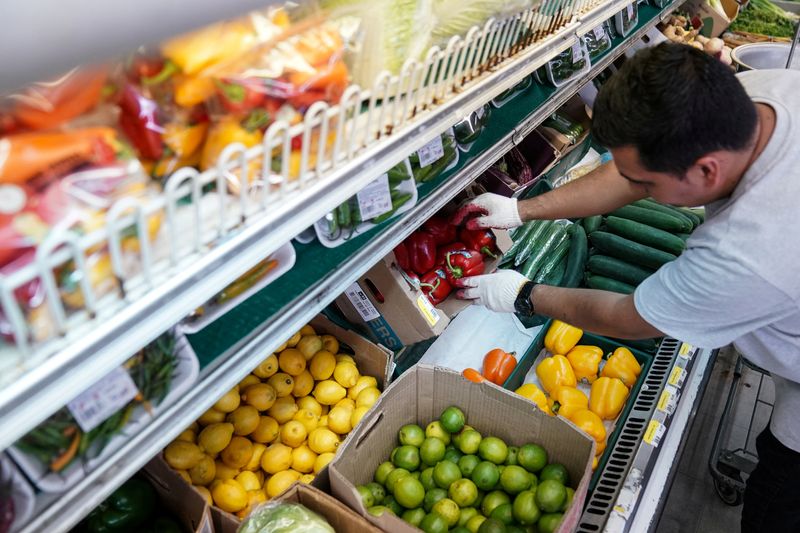By Lucia Mutikani
WASHINGTON (Reuters) - U.S. monthly inflation was unchanged in May as a modest increase in the cost of services was offset by the largest drop in goods prices in six months, drawing the Federal Reserve closer to start cutting interest rates later this year.
The report from the Commerce Department on Friday also showed consumer spending rose marginally last month. Underlying prices advanced at the slowest pace in six months, raising optimism that the U.S. central bank could engineer a much-desired "soft landing" for the economy in which inflation cools without triggering a recession and a sharp rise in unemployment.
Traders raised their bets for a Fed rate cut in September.
"This was a very Fed-friendly report that should keep the September rate cut in play, while at the same time increasing investor confidence that moderate economic growth can be maintained even as rates stay higher for longer," said Scott Anderson, chief U.S. economist at BMO Capital Markets. "The sharp slowdown in core inflation is just what the doctor needed to see to keep the economy on the soft-landing glide-path."
The flat reading in the personal consumption expenditures (PCE) price index last month followed an unrevised 0.3% gain in April, the Commerce Department's Bureau of Economic Analysis said. It was the first time in six months that PCE inflation was unchanged. Goods prices fell 0.4%, the biggest drop since November.
There were big declines in prices of recreational goods and vehicles as well as furnishings and durable household equipment.
The price of gasoline and other energy goods dropped 3.4%, the biggest slide in six months. Clothing and footwear were also cheaper, while food prices rose marginally.
The cost of services increased 0.2%, lifted by higher prices for housing and utilities as well as healthcare. Financial services and insurance costs declined 0.3% after rising for five straight months. These costs, together with housing, have been among the major drivers of services inflation.
In the 12 months through May, the PCE price index increased 2.6% after advancing 2.7% in April. Last month's inflation readings were in line with economists' expectations.
Inflation is receding after spiking in the first quarter as 525 basis points worth of rate hikes from the Fed since 2022 cool domestic demand. Inflation, however, continues to run above the central bank's 2% target.
Financial markets saw a roughly 68% chance that the Fed's policy easing would start in September compared to about 64% before the data, though policymakers recently adopted a more hawkish outlook. The U.S. central bank has maintained its benchmark overnight interest rate in the current 5.25%-5.50% range since last July.
Economists were divided on whether the Fed would still reduce borrowing costs twice this year amid solid wage growth. The release of the U.S. employment report for June next Friday could shed more light on the monetary policy outlook.
Stocks on Wall Street were trading largely higher. The dollar was little changed against a basket of currencies. U.S. Treasury prices were mixed.
SPENDING RISES MODERATELY
Excluding the volatile food and energy components, the PCE price index edged up 0.1% last month, the smallest gain since November. That followed an upwardly revised 0.3% rise in April.
The so-called core PCE price index was previously reported to have climbed 0.2% in April. Core inflation increased 2.6% on a year-on-year basis in May, the smallest advance since March 2021, after rising 2.8% in April.
It rose at a 2.7% annualized rate over the past three months, slowing from a 3.5% pace in April.
The Fed tracks the PCE price measures for its inflation target. Monthly inflation readings of 0.2% over time are necessary to bring inflation back to target.
PCE services inflation excluding energy and housing also ticked up 0.1% last month after advancing 0.3% in April. This measure is being watched by policymakers to measure progress in lowering price pressures.
Consumer spending, which accounts for more than two-thirds of U.S. economic activity, increased 0.2% last month after rising 0.1% in April, the report also showed. Spending was supported by a 0.3% gain in services, mostly outlays on hospital care, housing and utilities as well as air transportation. Services spending increased 0.4% in April.
Goods spending rebounded 0.2%, lifted by outlays on prescription medication, recreational goods and vehicles, and clothing and footwear. Spending on goods fell 0.5% in April.
Inflation fatigue, higher borrowing costs as well as the exhaustion of excess savings accumulated during the COVID-19 pandemic are holding back spending. Nonetheless, consumer spending remains underpinned by a resilient labor market, which continues to generate strong wage gains. Personal income increased 0.5% after climbing 0.3% in April. Wages shot up 0.7%, which some economists said could concern policymakers.
Income at the disposal of households after accounting for inflation and taxes rose a solid 0.5%. Consumers saved more, lifting the saving rate to 3.9% from 3.7% in April.
Spending adjusted for inflation rebounded 0.3% after slipping 0.1% in April. The rise in the so-called real consumer spending left growth in consumption this quarter on track to match the first quarter's 1.5% pace.

The Atlanta Fed is currently estimating gross domestic product to rise at a 2.2% rate in the second quarter. The economy grew at a 1.4% pace in the first quarter.
"There was no inflation in May, but there was also no indication of the kind of soft demand - undermined by slower income growth - the Fed believes necessary to keep inflation on a low track," said Chris Low, chief economist at FHN Financial.